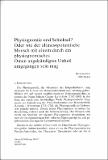Por favor, use este identificador para citar o enlazar a este item:
http://hdl.handle.net/10261/20072COMPARTIR / EXPORTAR:
 SHARE
BASE SHARE
BASE
|
|
| Visualizar otros formatos: MARC | Dublin Core | RDF | ORE | MODS | METS | DIDL | DATACITE | |

| Título: | Physiognomie und Schicksal? Oder wie der altmesopotamische Mensch mit einem durch ein physiognomisches Omen angekündigtes Unheil umgegangen sein mag |
Autor: | Böck, Barbara CSIC ORCID | Palabras clave: | Omen Prayer Destinity Ancient Mesopotamia Spells Phisiognomy Destino Presagios Conjuras Oraciones Antigua Mesopotamia Fisiognómica |
Fecha de publicación: | 2002 | Editor: | Consejo Superior de Investigaciones Científicas (España) | Citación: | Sefarad: revista de estudios hebraicos, sefardíes y de Oriente 62 (2): 241-257 (2002) | Resumen: | [EN] In my Die babylonisch-assyrische Morphoskopie, Wien 2000 (= AfO Bh. 27) I discussed the practical use of the cuneiform handbook of physiognomic omens, Alamdimmû. In comparison with morphoscopic treatises in Greek, Latin, Syriac, Arabic, and Hebrew I came to the conclusion that also the Akkadian handbook served as instrument for the checking and examination of people once they would enter the service of the king or, when applied to women, once they would get married. In the present paper I pose the question whether in case of an ill-portending physiognomy the person described in the Alamdimmû treatise could himself perform apotrapaic rituals or undertake other protective measures. [ES] En nuestro estudio Die babylonisch-assyrische Morphoskopie, Wien 2000 (= AfO Bh. 27)), incluimos una discusión sobre el uso que pudo tener el libro cuneiforme sobre presagios fisiognómicos denominado, en acadio, AlaindiininO. Por analogía con los tratados de morfoscopia en lengua griega, latín, siríaco, árabe y hebreo. propusimos entonces que Alaa~di>ii>tilpi udo servir para examinar al personal antes de su posible incorporación al servicio del rey, o bien, si se trataba de mujeres, antes de que contrajesen matrimonio. En este estudio planteamos la posibiiidad de que, si se producía un presagio fisiognómico ominoso, la persona implicada podía recurrir a medidas apotropaicas o de otro tipo para librarse del destino funesto que le aguardaba. |
Versión del editor: | http://sefarad.revistas.csic.es/index.php/sefarad/article/view/557 | URI: | http://hdl.handle.net/10261/20072 | ISSN: | 0037-0894 | E-ISSN: | 1988-0894 |
| Aparece en las colecciones: | (CCHS-ILC) Artículos |
Ficheros en este ítem:
| Fichero | Descripción | Tamaño | Formato | |
|---|---|---|---|---|
| 20091111094032576.pdf | 897,49 kB | Adobe PDF |  Visualizar/Abrir |
CORE Recommender
Page view(s)
283
checked on 17-abr-2024
Download(s)
107
checked on 17-abr-2024
Google ScholarTM
Check
NOTA: Los ítems de Digital.CSIC están protegidos por copyright, con todos los derechos reservados, a menos que se indique lo contrario.
